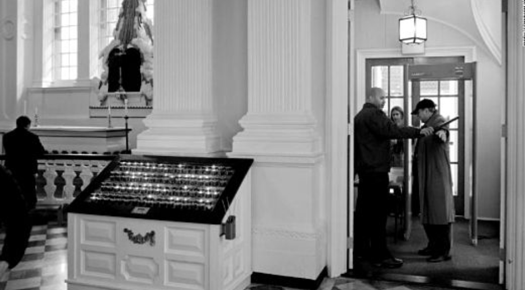
Trinity Church and St. Paul's Chapel, two historical churches with roots in the 17th century, installed metal detectors at their entrances in order to keep up with 21st century security concerns. Church visitors now form a line to go through airport-style metal detectors along with security guards checking them. These two churches, stationed near the World Trade Center in the lower Manhattan, are the latest city tourist sites to embrace post-9/11 security measures. According to church officials, the decision to raise the security level was not a response to any specific threat, but a terrorist attack in the fall, when a man used a speeding truck to kill eight people on a nearby bike path, had some influence on the decision.
“There is no imminent threat to Trinity or St. Paul’s,” said church spokeswoman Patti Walsh, adding that planning for the checkpoints “has been in the works for some time. “That said, lower Manhattan is considered to be one of the country’s top terrorist targets,” said Walsh. “While it saddens us to implement these measures, the times we live in necessitate this action.”
Lower Manhattan tourist sites already have metal detectors and other security measures. For example, people visiting the Statue of Liberty or the September 11 Memorial all have to pass through metal detectors, and The New York Stock Exchange closed to tourists altogether after 9/11. But seeing metal detectors at the entrance of the historical church still struck some visitors as something new, for instance St. Patrick's Cathedral, which gets an estimated 5 million visitors a year, does not have them. The officials of St. Patrick's Cathedral considered metal detectors in 2002, after a man shoot himself in the head at the parish house, but in the end decided to use them only for special events. Some visitors think that the sight of metal detectors at the doors sort of brings attention and sends the message that something happened or will happen.
Metal detectors remain rare at U.S. churches, even in security-conscious New York. Some think that this type of security measures are not necessary and some churches, like in the case of St. Patrick's Cathedral, refuse to accept that any place with lots of people is a potential target. The officials of Trinity Church and St. Paul's Chapel made good decision according to experts. “Any church, frankly, is a potential target, but these are landmark churches that represent the country in a way,” said terrorism expert Rick Mathews, of the University of Albany’s College of Emergency Preparedness, Homeland Security and Cyber security. “I think these kinds of precautions right now are pretty prudent. Churches have been a little slow in taking these kinds of measures.”
Photo Credits: The Tribune
